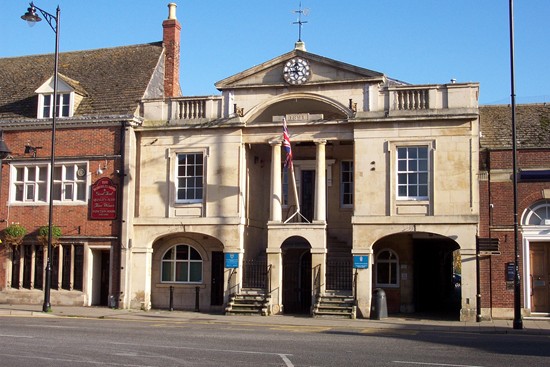|
- The market town of Bourne, Lincolnshire, England - |
The Town Hall

|
THERE HAS BEEN a building in the market place at Bourne serving as a town hall for centuries and it was also the centre of the community and particularly for the dispensation of justice through the Petty and Quarter Sessions and the meetings of the various manorial courts that controlled land and property and heard grievances. The earliest reference to a town hall is in 1586 and can be found in an account of the town by the historian William Camden (1551-1623) in Britannia, his survey of the British Isles, which says:
William Cecil, the Elizabethan statesman and the first Lord Burghley, was born at a house in the market place, now the Burghley Arms, and although Burghley House near Stamford later became his principal residence, it is most likely that he remembered his birthplace by bestowing a new town hall. This building probably stood somewhere near the junction of South Street and West Street and underneath it would have been a shambles and stalls that formed part of the weekly market while the Petty and Quarter Sessions were held in the town hall itself, together with the court of the manor of Bourne of which the Lord was the Marquess of Exeter and both he and his ancestors had been accustomed to receive tolls from the market which also extended to the shops and stalls. By the early 19th century, the town hall had become dilapidated and a site occupied by a house adjoining the Bull Inn (now the Burghley Arms) on the east side of the market place was chosen for a new building but this too was to have a shambles or set of stalls underneath. It was completed in 1821 to designs drawn up by the architect Bryan Browning who also designed Folkingham goal in 1825. He chose an exterior staircase and recessed twin flights of steps within the front of the building that was constructed with Doric columns after the fashion of the Roman baths. The project was financed with money raised through the county rate, from the sale of salvaged materials from the previous building on the site and from public subscription with contributions not only from Bourne but also from neighbouring parishes such as Market Deeping, Morton and Haconby, which between them raised just under £1,400. A large painted board containing the names of the original subscribers and the amount they contributed is still on display in the main courtroom. The town hall has remained in use ever since and is relatively unchanged except that the shambles has disappeared although the market is still in the vicinity, occupying a purpose built precinct at the rear. The interior of the Town Hall was altered in 1974-75 and the new layout reduced the size of the main courtroom but it continued as the seat of justice in Bourne and the magistrates' court was held there weekly for summary jurisdiction with a public gallery for anyone who wished to watch the proceedings. The court room was also used for regular meetings of the town council and there was an adjoining library or committee room where the magistrates adjourned to consider their decisions when necessary. Court sittings, however, were phased out in April 2008 and all hearings are now held at Spalding, Grantham, and elsewhere in the county. The Town Hall continued in use by the town council and for district and county council services until March 2013 when all were transferred to a new Community Access Point established at the Corn Exchange, together with the public library from South Street and register office from West Street. The Grade II listed building is currently in the care of Lincolnshire County Council and a public consultation is underway to decide its future. |
Return to HOME PAGE MAIN INDEX
![]()